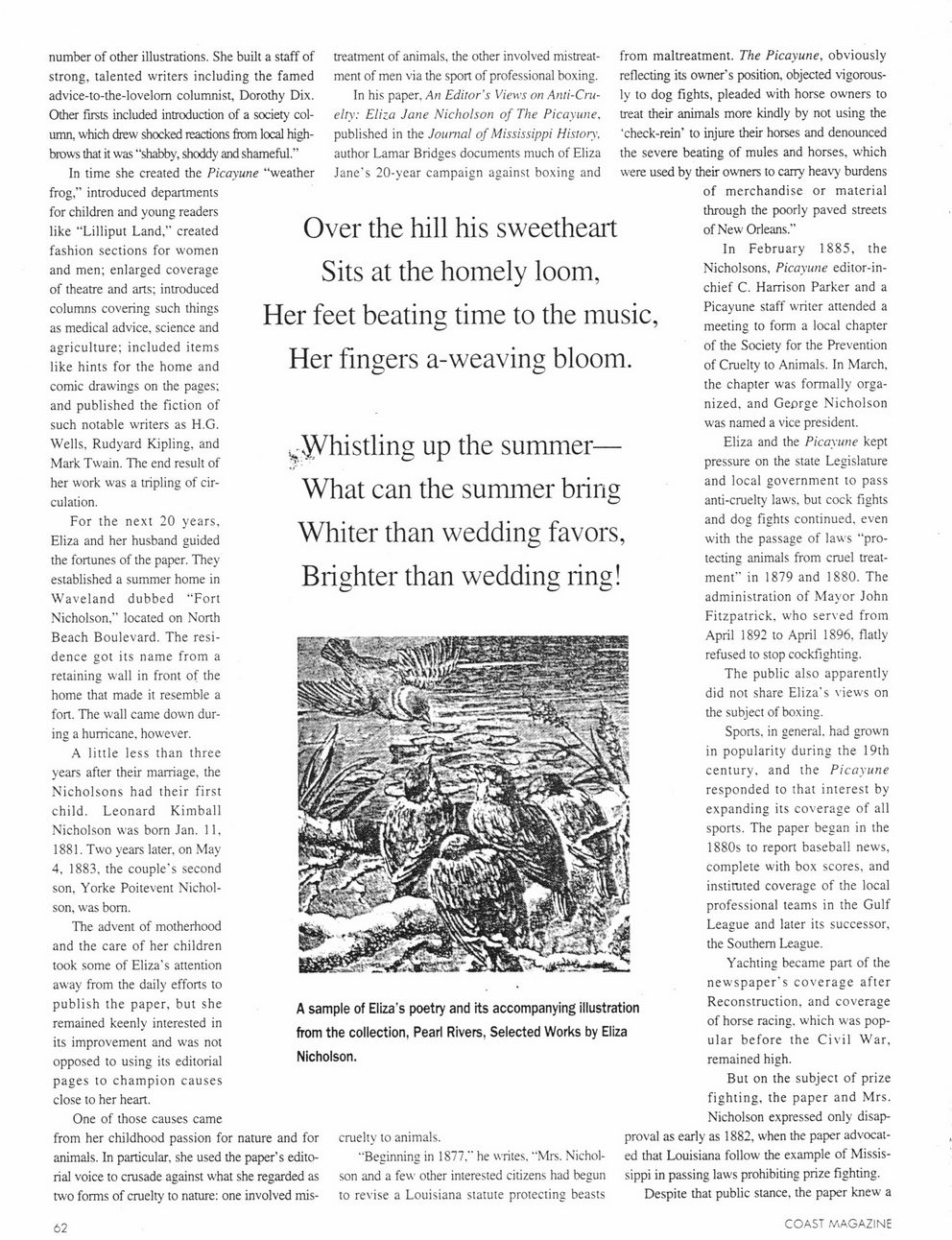This text was obtained via automated optical character recognition.
It has not been edited and may therefore contain several errors.
number of other illustrations. She built a staff of strong, talented writers including the famed advice-to-the-lovelom columnist, Dorothy Dix. Other firsts included introduction of a society column, which drew shocked reactions from local highbrows that it was ?shabby, shoddy and shameful.? In time she created the Picayune ?weather frog,? introduced departments for children and young readers like ?Lilliput Land,? created fashion sections for women and men; enlarged coverage of theatre and arts; introduced columns covering such things as medical advice, science and agriculture; included items like hints for the home and comic drawings on the pages; and published the fiction of such notable writers as H.G. Wells, Rudyard Kipling, and Mark Twain. The end result of her work was a tripling of circulation. For the next 20 years, Eliza and her husband guided the fortunes of the paper. They established a summer home in Waveland dubbed ?Fort Nicholson,? located on North Beach Boulevard. The residence got its name from a retaining wall in front of the home that made it resemble a fort. The wall came down during a hurricane, however. A little less than three years after their marriage, the Nicholsons had their first child. Leonard Kimball Nicholson was born Jan. 11, 1881. Two years later, on May 4. 1883, the couple?s second son, Yorke Poitevent Nicholson, was bom. The advent of motherhood and the care of her children took some of Eliza?s attention away from the daily efforts to publish the paper, but she remained keenly interested in its improvement and was not opposed to using its editorial pages to champion causes close to her heart. One of those causes came from her childhood passion for nature and for animals. In particular, she used the paper?s editorial voice to crusade against what she regarded as two forms of cruelty to nature: one involved mis- treatment of animals, the other involved mistreatment of men via the sport of professional boxing. In his paper. An Editor?s Views on Anti-Cruelty: Eliza Jane Nicholson of The Picayune, published in the Journal of Mississippi History, author Lamar Bridges documents much of Eliza Jane's 20-year campaign against boxing and cruelty to animals. ?'Beginning in 1877." he writes. "Mrs. Nicholson and a few other interested citizens had begun to revise a Louisiana statute protecting beasts from maltreatment. The Picayune, obviously reflecting its owner?s position, objected vigorously to dog fights, pleaded with horse owners to treat their animals more kindly by not using the ?check-rein? to injure their horses and denounced the severe beating of mules and horses, which were used by their owners to carry heavy burdens of merchandise or material through the poorly paved streets of New Orleans.? In February 1885, the Nicholsons, Picayune editor-in-chief C. Harrison Parker and a Picayune staff writer attended a meeting to form a local chapter of the Society for the Prevention of Cruelty to Animals. In March, the chapter was formally organized, and George Nicholson was named a vice president. Eliza and the Picayune kept pressure on the state Legislature and local government to pass anti-cruelty laws, but cock fights and dog fights continued, even with the passage of laws ?protecting animals from cruel treatment" in 1879 and 1880. The administration of Mayor John Fitzpatrick, who served from April 1892 to April 1896, flatly refused to stop cockfighting. The public also apparently did not share Eliza's views on the subject of boxing. Sports, in general, had grown in popularity during the 19th century, and the Picayune responded to that interest by expanding its coverage of all sports. The paper began in the 1880s to report baseball news, complete with box scores, and instiruted coverage of the local professional teams in the Gulf League and later its successor, the Southern League. Yachting became pan of the newspaper's coverage after Reconstruction, and coverage of horse racing, which was popular before the Civil War, remained high. But on the subject of prize fighting, the paper and Mrs. Nicholson expressed only disapproval as early as 1882, when the paper advocated that Louisiana follow the example of Mississippi in passing laws prohibiting prize fighting. Despite that public stance, the paper knew a Over the hill his sweetheart Sits at the homely loom, Her feet beating time to the music, Her fingers a-weaving bloom. ^-JVhistling up the summer? What can the summer bring Whiter than wedding favors, Brighter than wedding ring! O CO A sample of Eliza's poetry and its accompanying illustration from the collection, Pearl Rivers, Selected Works by Eliza Nicholson. 62 COAST MAGAZINE

Pearl Rivers Reflections Eliza Jane Poitenent -part4